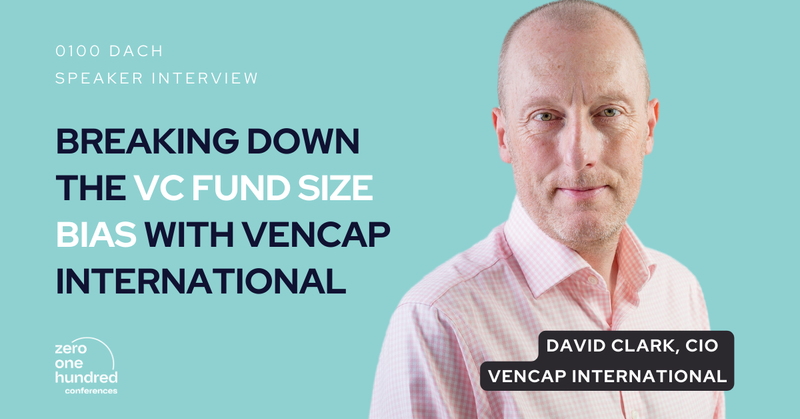David Clark, CIO at VenCap International, will deliver a keynote at 0100 DACH in Vienna on "What the VC Power Law Means in Practice." Ahead of the event, we spoke with him to challenge the notion that fund size determines success, arguing that strategy, founder access, and track record matter far more. Clark also debunks the small fund outperformance myth, explains how LPs should assess managers, and shares why VenCap prioritizes proven winners over emerging managers.

How do you define the size of a VC fund? What constitutes a small, medium, or large fund? Does this classification vary by geography?
We tend not to think about small vs medium vs large funds. We think this is the wrong way to approach venture capital. It’s much more about finding the right fund size for the strategy you are trying to implement and for the size of exits you are likely to achieve. For example, the best-performing fund we have backed over the last 15 years is an $800m fund that is generating over 13x. Being too fixated on relative fund size ultimately misses the key point for VC firms – namely, backing the top 1% of founders. I’d take a large fund investing in the very best companies vs a small fund investing in second-tier firms every day of the week.
Why is it important to challenge the bias around VC fund sizes?
The data that people use to justify the small funds outperform thesis is fundamentally flawed. Firstly, it represents a tiny proportion of the actual venture funds that have been raised. Secondly, there is typically a huge survivorship bias within this data. And finally, the very best VC firms tend not to share their performance data publicly. If you’re going to base your investment strategy around a specific dataset, then you really need to ensure that dataset is robust, reliable and provides statistically significant signal.
How do you balance fund size with the power law in VC? Is there a direct correlation between them?
We know that the top 1% of companies generate more than half of the total exit value created by the VC industry globally. Our data also tells us that the vast majority of VC funds that return 3x or more have at least one company that returns the entire fund. So when we underwrite a new fund investment, the key question we ask ourselves is what do we have to believe for this fund to generate a fund returner. If they are raising a $1 billion fund, then they need to own 10% of a $10 billion company. And then the question becomes how often have they achieved this in their prior funds? If the answer is never, then you’re essentially betting on that manager getting lucky. For us, hoping you get lucky isn’t really a viable investment strategy.
As an LP, what are the key factors you prioritize when screening VC funds?
We think the single best predictor of whether a manager is able to back a top 1% company and generate a fund-returning outcome from the investment is how many times they have done this previously. We simply won’t engage with a manager unless we see strong evidence of their ability to consistently back the very best founders. And the best founders have almost infinite options when it comes to raising capital so the bar for backing their companies is incredibly high.
For emerging managers without a strong track record, what strategies can LPs use to analyze them?
We specifically won’t invest in emerging managers because we don’t believe there is a consistent way of separating the signal from the noise. Some LPs may have found a way of achieving this, but unfortunately, we’re not one of them. So the very earliest we have historically invested with a new manager would be fund 3. And today, given the accelerated deployment times for recent funds and the increased holding periods, it might actually be more like a fund 4 or 5 before we start to see reliable signal.
What is VenCap’s approach to specialized managers vs. generalists?
We don’t believe that we, as LPs, have the ability to predict which sectors are going to generate the top 1% companies in a decade’s time. As such, we don’t invest in specialized managers. We’ve actually found that the best generalist managers continue to attract the best founders across multiple technology cycles. Interestingly, look at which managers were the early investors in the leading AI companies. Khosla Ventures was the first VC fund to invest in OpenAI. Lightspeed led the seed round for Mistral. Spark Capital was the early investor in Anthropic, while Andreessen Horowitz and Thrive Capital were the A-round investors in Cursor, which recently became the fastest-ever company to $100m in revenue.
As a fund-of-funds (FoF), do you focus on specific sectors? If so, which ones and why?
We believe our expertise is accessing the very best managers, not trying to pick sectors. As such, we are essentially sector-agnostic when it comes to our VC investments. We prefer to back the best managers and then let them decide where the best opportunities are coming from. By the time a sector becomes attractive to LPs, it’s usually a sign that we’re close to the top of the market. In addition, VC returns are so concentrated that picking the right sector isn’t sufficient. You also have to pick the top one or two companies within that sector. Ultimately, it comes back to finding those managers who can consistently back the top 1% companies. We have found this to be the most reliable way of generating consistent top-quartile returns for our investors.

